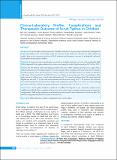Please use this identifier to cite or link to this item:
https://hdl.handle.net/20.500.14356/1289| Title: | Clinico-Laboratory Profile, Complications and Therapeutic Outcome of Scrub Typhus in Children |
| Authors: | Chapagain, Ram Hari Agrawal, Sumit Pokharel, Sunita Kayastha, Madhusudhan Bhattrai, Susan Jha, Anshu Gauchan, Prerana Adhikari, Santosh Giri, Bishnu Rath Sah, Ravindra kumar |
| Citation: | ChapagainR. H., AgrawalS., PokharelS., KayasthaM., BhattraiS., JhaA., GauchanP., AdhikariS., GiriB. R., & SahR. kumar. (2020). Clinico-Laboratory Profile, Complications and Therapeutic Outcome of Scrub Typhus in Children. Journal of Nepal Health Research Council, 18(2), 282-287. https://doi.org/10.33314/jnhrc.v18i2.2730 |
| Issue Date: | 2020 |
| Publisher: | Nepal Health Research Council |
| Article Type: | Original Article |
| Keywords: | Clinico-laboratory profile complications fever scrub typhus |
| Series/Report no.: | Apr-June, 2020;2730 |
| Abstract: | Abstract Background: Scrub typhus, an important cause of undifferentiated fever, is grossly neglected and often misdiagnosed in low and middle income countries like Nepal. The main aim of this study was to describe the clinico-laboratory profile, drug used in treatment, predictor of PICU admission and therapeutic outcome of serologically confirmed scrub typhus among Nepalese children. Methods: A prospective observational study was carried out in children aged up to 14 years with serologically (IgM ELISA) diagnosed Scrub typhus, admitted in a tertiary care hospital of central Nepal between Jan 2019 to Dec 2019. Results: All 100 children with scrub typhus presented with fever. Other symptoms and sign were cough (29%), abdominal distension (22%) hepatomegaly (45%), splenomegaly (28%), crepitation (10%) and eschar (6%). Similarly, thrombocytopenia (72%), and increased liver enzymes SGPT (51%) and SGOT (62%) were found. Co-infection with dengue (5%) brucella (5%) and UTI (5%) were seen. Thirty six percent has some form of complication. Fifty eight percent of children were treated with azithromycin and 25% treated with doxycycline. The mean length of hospital stay was 6.68 ±2.97 days with a mean duration of defervescence being 30.07 ± 26.65 hours. The increased risk of PICU admission was found in those children with crepitation in chest (OR: 15.17, 95% CI: 3.4-66.8) during presentation and those children not getting azithromycin as treatment (OR: 3.8, 95% CI: 1.2-11.7) Conclusions: Scrub typhus should be considered as a differential diagnosis in any community acquired acute undifferentiated febrile illness regardless of the presence of an eschar. Sepsis, meningitis and pneumonia are important complications. Child having crepitation on presentation has an increased chance admission in critical care unit. The child receiving azithromycin has less chance to land in PICU. Keywords: Clinico-laboratory profile; complications; fever; scrub typhus. |
| Description: | Original Article |
| URI: | http://103.69.126.140:8080/handle/20.500.14356/1289 |
| ISSN: | Print ISSN: 1727-5482; Online ISSN: 1999-6217 |
| Appears in Collections: | Vol. 18 No. 2 Issue 47 Apr-Jun 2020 |
Files in This Item:
| File | Description | Size | Format | |
|---|---|---|---|---|
| 2730-Manuscript-17532-1-10-20200911.pdf | Fulltext Download | 243.27 kB | Adobe PDF |  View/Open |
Items in DSpace are protected by copyright, with all rights reserved, unless otherwise indicated.
